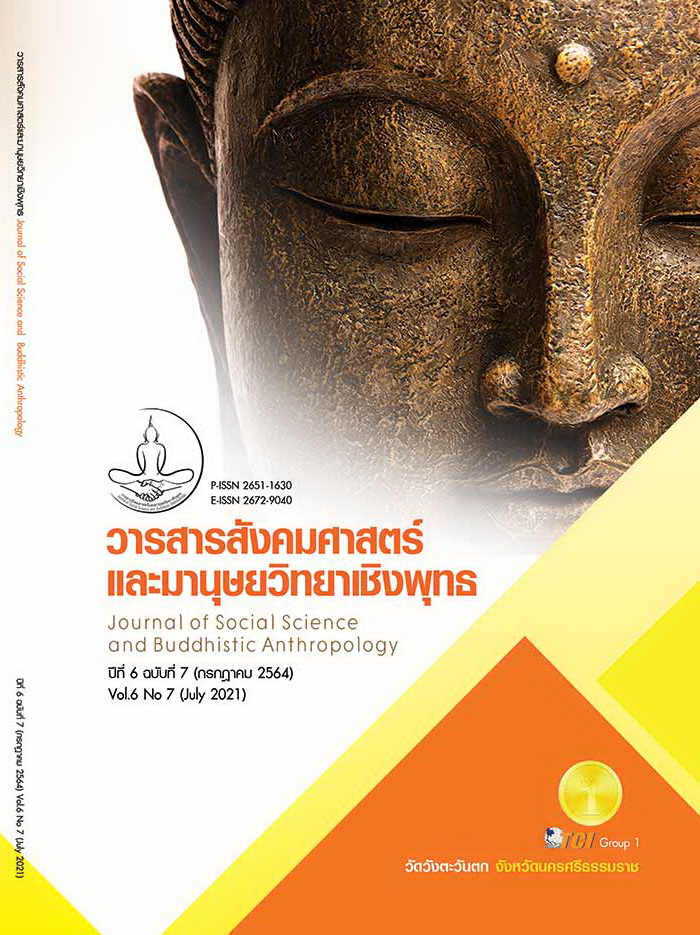INTEGRATED AGRICULTURE MANAGEMENT MODEL FOR SUSTAINABLE DEVELOPMENT IN THE PAK PANANG RIVER BASIN, NAKON SI THAMMARAT
Keywords:
Management Model, Integrated Agriculture, Sustainable DevelopmentAbstract
The objectives of this research article were to study the Integrated agriculture management model for sustainable development in the Pak Panang River Basin, Nakhon Si Thammarat. The research objectives were as follows: 1) to study the factors affecting the integrated agriculture management model for sustainable development 2) to develop a model of integrated agriculture for sustainable development of farmers. Integrated agriculture will lead to the sustainable development of Thai farmers. To have income stability, society, and environment. There was 3 step for this research. The first step is to study quantitative research. Using questionnaires ask opinions of farmers representatives of 398 samples. The data were analyzed by using statistical mean (), standard deviation (S.D.), Pearson's product - moment correlation coefficient, and Multiple regression analysis (MRA). The second step, Conduct qualitative research. With the use of in - depth interviews Interview with representatives from government agencies, community leaders, and 10 farmers. Using a direct content analysis method. The last step, a group discussion with 7 expert scholars. The research found that: 1) Factors affecting the management of integrated agriculture. The average value was at a moderate level. 2) The sustainability level of integrated agriculture. 3) The relationship between factors of the integrated agricultural management model in the understanding of integrated agriculture. Inputs management and advice from the government sector. There was a very positive relationship with the sustainability of integrated agriculture. Has a forecasting power of 58.08 percent, a statistically significant .05 and 4) The effect of the integrated agriculture management model for sustainable development in the Pak Phanang River Basin. Nakhon Si Thammarat Province consists of 1) awareness of the value of sustainability, 2) self - development through integrated agriculture, 3) efficient resource allocation, and 4) life and happiness arising from community connections.
References
กฤศณัฏฐ์ เมธวินชยุตม์ และคณะ. (2559). การจัดการความรู้สู่แผนชุมชนพึ่งตนเองเพื่อการพัฒนาอย่างยั่งยืนของชุมชนตามแนวชายแดนไทย-กัมพูชา. วารสารสารสนเทศศาสตร์ (บรรณารักษ์ศาสตร์ มข.), 34(1), 1-25.
กีรติพร จูตะวิริยะ และพัชรินทร์ ลาภานันท์. (2557). เกษตรผสมผสาน: ยุทธศาสตร์การดำรงชีพของเกษตรกรอีสานภายใต้กระแสโลกาภิวัตน์. วารสารสังคมลุ่มน้ำโขง, 10(3), 25-48.
จำเนียร จวงตระกูล. (2553). การวิจัยเชิงคุณภาพ: เครื่องมือสร้างองค์ความรู้เพื่อการพัฒนาประเทศ. กรุงเทพมหานคร: บริษัท ศูนย์กฎหมายธุรกิจอินเตอร์เนชั่นแนล จำกัด.
. (2561). ปัญหาการกำหนดกลุ่มตัวอย่างและวิธีการสุ่มตัวอย่างในการวิจัยเชิงคุณภาพ. วารสารการบริหารธุรกิจและสังคมศาสตร์มหาวิทยาลัยรามคำแหง, 1(2), 1-21.
จำเนียร จวงตระกูล และนวัสนันท์ วงศ์ประสิทธิ์. (2562). การวิเคราะห์เนื้อหาในการวิเคราะห์ข้อมูลการวิจัยเชิงคุณภาพ. PAAT Journal, 2(2), 1-14.
จุฬาภรณ์ ถาวร. (2550). การศึกษาปัจจัยที่เกี่ยวข้องกับการทำเกษตรกรรมยั่งยืนของแกนนำเกษตรกรจังหวัดสุพรรณบุรี. กรุงเทพมหานคร: มหาวิทยาลัยศรีนครินทรวิโรฒ.
ฉัตรวรัญ องคสิงห์. (2558). ผู้หญิงกับการเปลี่ยนแปลงเชิงเศรษฐกิจ ศึกษากรณีเศรษฐกิจพอเพียงจังหวัดอ่างทอง. วารสารปัญญาภาวัฒน์, 7(1), 173-184.
ธนภูมิ ธราวุธ และคณะ. (2560). รูปแบบการสร้างความเข้มแข็งของชุมชนและสังคม ตามแนวปรัชญาของเศรษฐกิจพอเพียง กรณีศึกษาจังหวัดสุพรรณบุรี. วารสารการบริหารท้องถิ่น, 10(1), 34-52.
นงนภัส คู่วรัญญู เที่ยงกมล. (2552). สิ่งแวดล้อมและการพัฒนา (ความมั่นคงทางอาหาร) เล่ม 2. กรุงเทพมหานคร: สำนักพิมพ์แห่งจุฬาลงกรณ์มหาวิทยาลัย.
นภาพร เวชกามา และรัตน์ ชิณแสน. (2558). รูปแบบเกษตรประณีตเพื่อพัฒนาอาชีพสู่ความยั่งยืน: กรณีศึกษาเกษตรกรตำบลนาโส่ อำเภอกุดชุม จังหวัดยโสธร. วารสารเกษตรพระวรุณ, 12(1), 59-66.
ปราณี หลําเบ็ญสะ. (2559). การหาคุณภาพของเครื่องมือวัดและประเมินผล โครงการบริหารวิชาการท่าสาบโมเดล. ยะลา: มหาวิทยาลัยราชภัฏยะลา.
พระใบฎีกาสุพจน์ ตปสีโล. (2552). การศึกษาวิธีการเผยแพร่แนวพระราชดำริเศรษฐกิจพอเพียงของพระสงฆ์ในจังหวัดอุบลราชธานี ยโสธร และนครพนม. ใน รายงานการวิจัย. มหาจุฬาลงกรณราชวิทยาลัย.
พัชรพรรณ ยาโน. (2552). วิถีชีวิตกับการพัฒนาอาชีพของเกษตรกรแบบผสมผสานในจังหวัดชุมพร. กรุงเทพมหานคร: มหาวิทยาลัยศรีนครินทรวิโรฒ.
พัชรินทร์ สิรสุนทร. (2556). แนวคิด ทฤษฎี เทคนิค และการประยุกต์เพื่อการพัฒนาสังคม. กรุงเทพมหานคร: สำนักพิมพ์แห่งจุฬาลงกรณ์มหาวิทยาลัย.
ระพี สาคริก. (2553). แผ่นดินถิ่นเกิด เกษตรกรรม การศึกษาและอนาคตของแผ่นดิน. กรุงเทพมหานคร: ทางช้างเผือก.
สมชัย วงษ์นายะ และทวนทอง เชาวกีรติพงศ์. (2555). การพัฒนากลยุทธ์การบริหารจัดการหมู่บ้านในการดำเนินชีวิตตามหลักปรัชญาของเศรษฐกิจพอเพียงในจังหวัดกำแพงเพชรและจังหวัดตาก. วารสารมนุษยศาสตร์และสังคมศาสตร์ มหาวิทยาลัยราชภัฏกำแพงเพชร, 19(1), 31-42.
สำนักงานคณะกรรมการพัฒนาการเศรษฐกิจและสังคมแห่งชาติ. (2556). สัจธรรมแห่งแนวพระราชดำริสู่การพัฒนาอย่างยั่งยืน. กรุงเทพมหานคร: อมรินทร์พริ้นติ้งแอนด์พับลิชชิ่ง จํากัด (มหาชน).
สีลาภรณ์ บัวสาย และก้าน จันทร์พรหมมา. (2552). ลุ่มน้ำปากพนังจากความขัดแย้งสู่ความสมานฉันท์. กรุงเทพมหานคร: อมรินทร์พริ้นติ้งแอนด์พับลิชชิ่ง จํากัด (มหาชน).
สุชาติ ประสิทธิ์รัฐสุนธุ์. (2540). การวิจัยทางสังคมศาสตร์. กรุงเทพมหานคร: สถาบันบัณฑิตพัฒนบริหารศาสตร์.
อานัฐ ตันโช. (2556). ตำราเกษตรธรรมชาติประยุกต์ แนวคิด หลักการ เทคนิคปฏิบัติในประเทศไทย. เชียงใหม่: สำนักพิมพ์ทรีโอแอดเวอร์ไทซิ่ง แอนด์ มีเดีย.
Creswell, J. W. (1998). Qualitative Inquiry and Research Design: Choosing Among Five Traditions. Thousand Oaks: Sage.
. (2013). Qualitative Inquiry & Research Design: Choosing Among Five Approaches. (3rd ed.). Thousand Oaks, California: SAGE.
Hsieh, H-F. & Shannon, S. E. (2005). Three Approaches to Qualitative Content Analysis. Qualitative Health Research, 15(9), 1277-1288.
Joungtrakul, J. et al. (2013). Qualitative Data Collection Tool: A New Approach to Developing an Interview Guide. AFBE Journal, 6(2), 140-154.
Korstjens, I. & Moser, A. (2018). Practical guidance to qualitative research. Part 4: Trustworthiness and publishing. European Journal of General Practice, 24(1), 120-124.
Leu, A. (2558). มายาคติว่าด้วยสารกําจัดศัตรูพืชที่อ้างว่าปลอดภัย - The myths of safe pesticides. กรุงเทพมหานคร: สวนเงินมีมา.
Marshall, B. et al. (2013). Does Sample Size Matter in Qualitative Research?: A Review of Qualitative Interviews in IS Research. Journal of Computer Information Systems (Fall), 11-22. Retrieved May 29, 2020, from https://pdfs.semanticscholar.org
Maykut, P. & Morehouse, R. (1994). Beginning Qualitiative Research: A Philosophic and Practical Guide. London: The Falmers Press.
Patton, M. Q. (1990). Qualitative Evaluation and Research Methods. (2nd ed.). Newbury Park, California: Sage.
Yamane, T. (1973). Statistics: An Introductory Analysis. (3rd Ed.). New York: Harper and Row Publications.
Zhang, Y. & Wildemuth, B. M. (2009). Qualitative analysis of content. In B.M. Wildemuth (Ed.) ,Applications of Social Research Methods to Question information and Library Science (pp. 297-307). Westport, CT.: Libraries Unlimited.








